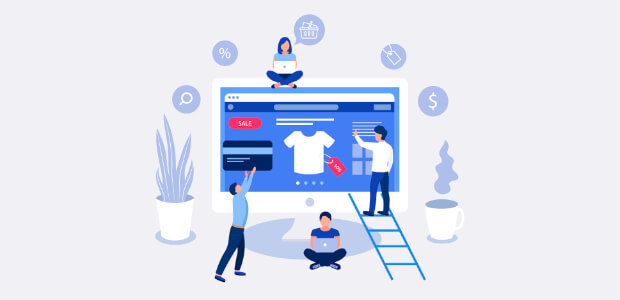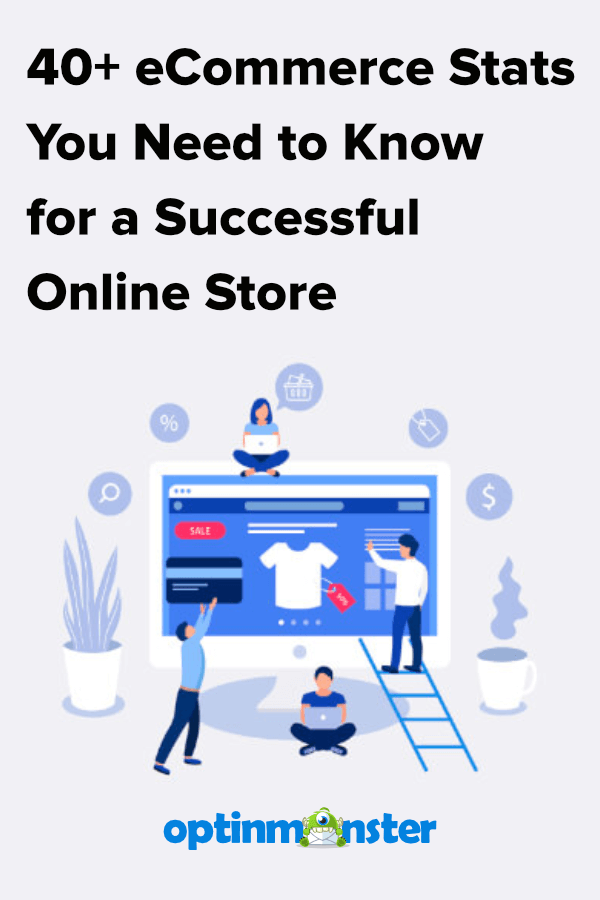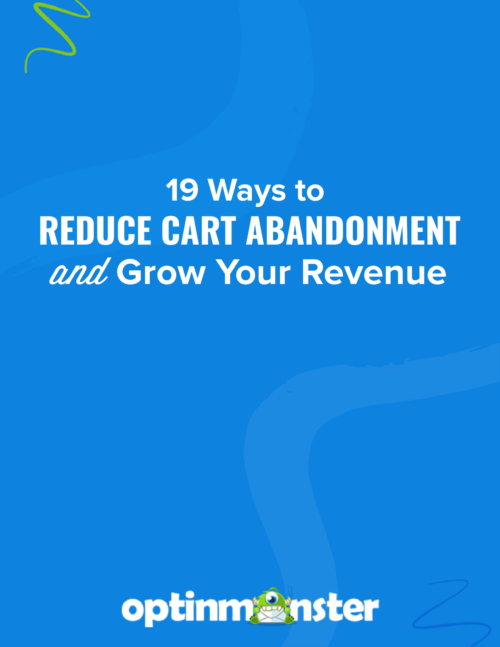Are you up to speed on the latest global ecommerce statistics?
If you’re interested in starting an online store or want to boost your ecommerce sales, knowing the newest ecommerce statistics will help you make data-driven decisions that will bring you results.
In this article, I’ll share 27 ecommerce statistics you need to know to run a successful online store.
Quick links:
- Ecommerce Growth Statistics
- Ecommerce Online Statistics
- Ecommerce Mobile Statistics
- Ecommerce Amazon Statistics
- Ecommerce Abandonment Statistics
- Ecommerce Shopping Statistics
- Ecommerce vs Retail Statistics
- Ecommerce Website Statistics
- Personalization Ecommerce Statistics
Ready? Let’s dive into the world of ecommerce.
Ecommerce Growth Statistics
Curious about the remarkable surge in ecommerce lately? The onset of the COVID-19 pandemic in 2020 triggered a significant upswing in online shopping, and this momentum is only getting stronger.
1. 2021 Saw a 27.6% Increase in Global Retail Ecommerce Sales
This is a notable decrease from the pandemic’s peak of 27.6% in 2020. These sales comprised approximately 19% of the entire global retail sales pie. It’s a safe bet that these figures will continue their upward trajectory year after year.
2. In 2021, an Impressive 2.14 Billion Shopped Online, Up From 1.66 Billion in 2016
Anticipated online shoppers for 2021 were an impressive 2.14 billion individuals, a significant leap from the 1.66 billion people who engaged in online shopping back in 2016.
Online Ecommerce Statistics
The dynamic realm of online eCommerce continues to surge, with global sales reaching newer heights, showcasing the unparalleled growth potential for businesses in the digital marketplace.
3. 76% of All United States Adults Shop Online
That’s still a ton of people, but let’s take a closer look at who is shopping online the most. According to Statista, online shopping by age group breaks down like this:
- 67% of Millenials prefer to shop online
- 56% of Generation X prefer to shop online
- 41% of Baby Boomers prefer to shop online
- 28% of seniors prefer to shop online
4. Nearly 80% of Younger Shoppers Make Impulse Purchases Online
Age makes a difference in buying behavior as well. For example, younger shoppers make more unplanned purchases than older shoppers.
So, why do people prefer to shop online?
The number one reason people shop online is that they can shop all day hours. Other top reasons people shop online are the ability to compare prices, get online sales, and save time.
Mobile Ecommerce Statistics
Mobile commerce has firmly established itself as the driving force behind online shopping, underlining the imperative for businesses to prioritize seamless mobile experiences for their customers.”
5. Last year, US mobile ecommerce via smartphones reached $117 billion
Part of the reason why online shopping is so popular is that it’s convenient. Consumers can pull out their smartphones, access an ecommerce website or app, and start shopping.
6. 65% of Shoppers Look Up Price Comparisons on Their Mobile Devices While in a Physical Store
You might be surprised to learn that even while shopping in a physical store, shoppers are still checking their phones.
7. 77% of Traffic Came From Mobile Devices in 2017, Up From 16% in 2012
Ecommerce website owners work hard to make sure their sites are optimized for mobile since that’s where much of their traffic comes from.
Amazon Ecommerce Statistics
We couldn’t create this list of ecommerce stats without mentioning the ecommerce giant, Amazon.
8. 44% of Online Shoppers Begin Their Product Search on Amazon Instead of Google
Amazon is like an ecommerce product search engine for many online shoppers.
9. Almost 66% of Americans Have Shopped on Amazon
Of course, it’s not only used to find products, but tons of people also buy from Amazon.
Related Content How to Make Money on Amazon: A Guide
10. Amazon, With 197 Million Monthly Users, Is the Top US Shopping App
The most popular products on Amazon are electronics (44%), followed closely by clothing, shoes, and jewelry (43%) and home and kitchen products (39%).
Ecommerce Abandonment Statistics
Shopping cart abandonment is one of the biggest challenges for global ecommerce websites.
11. Almost 70% of Shoppers Abandon Their Carts
When consumers abandon their shopping carts, that’s a missed opportunity to make a sale, and those missed opportunities add up.
Why do consumers abandon online stores?
An unexpected extra cost is the number one reason shoppers abandon carts. Other common causes of shopping cart abandonment include being required to create an account and a long and complicated checkout process.
To reduce shopping cart abandonment, you can create an exit-intent popup using OptinMonster to encourage users to return to their carts and buy.
For example, check out the cart abandonment exit-intent popup below from Gleam.
12. Abandoned Cart Emails Have an Average Open Rate of 45%
You can also use email marketing to combat shopping cart abandonment.
Using email marketing software, you can automatically send emails to your subscribers whenever they abandon their carts and convince them to return.
13. Emails Sent 20 Minutes Post-Cart Abandonment Have a 5.2% Conversion Rate
The best part? Abandoned cart emails work!
Ecommerce vs Retail Statistics
Just because online shopping is popular doesn’t mean retail brick-and-mortar shopping is dying.
14. In 2022, US Brick-and-Mortar Sales Hit $4.44 Trillion, With Ecommerce at $265 Billion
People love shopping at retail stores. They get to see and feel the products before buying, and they can take their product home immediately instead of waiting for it to be delivered. Retail shopping is something people can do with friends and family. It’s an experience and an event.
15. 1/3 of Customers Don’t Trust Retailers That Only Operate Online
Among the 4,400 surveyed US adults, 1,496 individuals expressed a lack of trust in brands that exclusively exist online.
P.S. If you want to start your own online business and are looking for a complete ecommerce launch checklist, read A 14-Point ecommerce Launch Checklist for New Store Owners.
Ecommerce Website Statistics
A user-friendly, professional-looking website is important if you want consumers to buy from your online store.
16. On Average, Only 2.86% of Ecommerce Website Visits Convert Into a Purchase
But just because you have an excellent website doesn’t necessarily mean shoppers will buy from you.
If you want to increase conversions on your ecommerce site, check out our guide on 15 Ecommerce User Experience Best Practices to Explode Your Sales.
And remember, don’t rely on your ecommerce website to make sales.
17. On Average, 52% of Online Stores Have Omnichannel Capabilities
This means they sell and communicate with customers through their website, Facebook Page, Instagram account, email list, and more.
Personalization Ecommerce Statistics
Shoppers want personalized online shopping experiences.
18. 74% of Consumers Get Frustrated With Irrelevant Content
By now, most marketers know how important ecommerce personalization is. 90% of marketers believe personalization is the future.
19. 48% of Consumers Spend More When Their Experience Is Personalized
Marketers see an average increase of 20% in sales when using personalized experiences
Ecommerce personalization examples include:
-
- Personalizing search results
- Sending personalized emails based on user behavior
- Recommending products based on browsing behavior
- Using geo-location targeting
Social Media Ecommerce Statistics
Facebook is no longer used just for staying connected to family and friends. It’s an excellent place for ecommerce businesses to promote their products and encourage online shoppers to buy.
20. 90 Million Small Businesses Use Facebook
Consumers can discover small ecommerce businesses on Facebook, click the “Shop Now” button, and start shopping.
21. 85% of Orders From Social Media Sites Come From Facebook
Plus, the average order value for customers referred from Facebook is $55
22. Instagram Reports 200 Million Users Visit a Business Profile Daily
And Instagram users aren’t just visiting these business profiles by chance; they’re visiting them because they’re looking for products to buy.
23. 60% say they discover new products on Instagram
24. 62% of customers Became More Interested in a Brand or Product After Seeing It on Instagram Stories
As you can see, promoting your products on Instagram is powerful. But are people buying directly on Instagram or window shopping?
The answer is buying.
25. 11% of US Social Media Users Shop on Instagram
With 130 million tapping shopping posts monthly.
Ecommerce Shopping Statistics
26. In 2021, Online Shoppers Are Set To Surpass 2.14 Billion, a Jump From 2016’s 1.66 Billion
27. It’s Estimated That Consumers Will Make 95% of Purchases Online by 2040
That’s it! These were the statistics for ecommerce we had in store for you for 2025.
How To Grow Your Ecommerce Store?
Now that we have read about ecommerce success, it’s time to take your store to the next level.
All ecommerce stores rely heavily on generating leads via popups. OptinMonster is the most powerful conversion optimization tool and email popups creator in the world because:
- OptinMonster’s powerful drag-and-drop builder allows you to create visually stunning optin forms optimized for the highest conversion rates.
- You can choose from the perfect campaign type to display the most attention-grabbing offers to your visitors for maximum engagement.
- You can detect your visitors’ behavior and use smart triggers to display the right campaign to the right person at the right time.
- It allows you to use precision targeting to create campaigns that generate more leads, attract more subscribers, and increase sales.
- You can create campaigns that react and adapt in real time so you can easily personalize, segment, and target for incredible conversions.
- You can get the stats that matter and the tools you need to take action and improve your lead-generation strategy.
By understanding the ecommerce industry, you can make informed decisions that can ultimately skyrocket your ecommerce sales.
If you loved this roundup of ecommerce statistics, check out our other post on online shopping statistics you need to know:
- The Ultimate eCommerce Optimization Guide: 13 Steps to Instantly Boost Revenue
- 15 eCommerce Marketing Ideas to Grow Your Online Sales
- 13 Ecommerce Personalization Examples (+5 Strategies for YOUR Store)
- eCommerce Best Practices: Set up Your Business for Success
- How to Use Conversational Commerce To Boost Sales and Brand Loyalty
- Getting Started With eCommerce Email Marketing Automation: 4 Campaigns Every Store Needs











Add a Comment